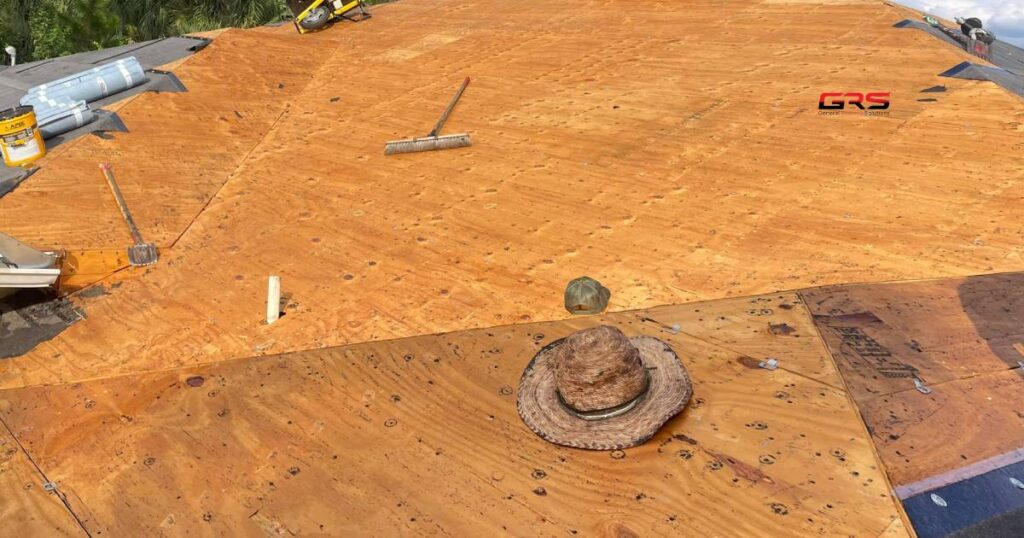Replacing a roof is a significant investment and a critical project for maintaining the safety and integrity of your home. Understanding what to expect during the roof replacement process can help you prepare and ensure everything goes smoothly. Whether you’re dealing with an aging roof, extensive damage, or simply upgrading to a more durable material, knowing the steps involved in a roof installation will make the experience less daunting. Ready to upgrade your home with a new roof? Contact us today for a free consultation and expert advice on your roof replacement and roof installation needs!

Why Roof Replacement is Necessary
A roof replacement becomes necessary when your existing roof has reached the end of its lifespan, sustained significant damage, or no longer performs as it should. Common signs that you may need a roof replacement include persistent leaks, missing or damaged shingles, and visible wear and tear. Ignoring these issues can lead to more severe problems, such as water damage, mold growth, and structural issues.
Opting for a roof replacement not only addresses these immediate concerns but also enhances the overall value and appearance of your home. With modern roof installation techniques and materials, you can achieve better energy efficiency, increased durability, and a fresh new look for your property.
The Roof Replacement Process
Understanding the roof replacement process can help you feel more confident and prepared when it’s time to start your project. Here’s a step-by-step overview of what to expect during your roof installation:
1. Initial Consultation and Inspection
The first step in the roof replacement process is an initial consultation with a roofing professional. During this stage, the contractor will assess your current roof’s condition, discuss your needs and preferences, and provide recommendations for the best materials and solutions for your roof installation. This inspection is crucial for identifying any underlying issues, such as water damage or structural weaknesses, which may need to be addressed during the roof replacement.
2. Choosing the Right Roofing Materials
One of the most important decisions you’ll make during your roof replacement is selecting the right materials for your new roof. The choice of roofing material will impact your home’s aesthetics, durability, and energy efficiency. Common options include asphalt shingles, metal roofing, wood shakes, and slate tiles. Your roofing contractor will help you weigh the pros and cons of each material based on your budget, climate, and design preferences.
Once you’ve chosen your materials, the contractor will order them and schedule the roof installation. It’s essential to select high-quality materials that suit your home’s needs to ensure a long-lasting and reliable roof replacement.
3. Preparing Your Home for Roof Installation
Before the roof installation begins, there are several preparations you’ll need to make to ensure the process goes smoothly. This includes:
Clearing the area: Remove vehicles, outdoor furniture, and any valuable items from around your home to create a safe workspace for the roofing crew.
Protecting your belongings: Cover items in your attic or upper floors to protect them from dust and debris that may fall during the roof replacement.
Informing your neighbors: Let your neighbors know about the upcoming roof installation so they can prepare for any noise or disruption.
By taking these steps, you can minimize the impact of the roof replacement on your daily life and ensure a safer environment for the roofing crew.
4. Removing the Old Roof
The roof replacement process begins with the removal of the old roof. The roofing crew will carefully strip away the existing shingles, underlayment, and any damaged decking. This step is critical for ensuring a clean slate for the new roof installation. Removing the old roof also allows the contractor to inspect the underlying structure for any damage or rot that needs to be repaired before proceeding with the roof replacement.
In some cases, a complete tear-off of the old roof is necessary, while in others, a roof overlay (installing a new roof over the old one) may be an option. Your roofing contractor will determine the best approach based on the condition of your current roof and local building codes.
5. Inspecting and Repairing the Roof Deck
Once the old roof is removed, the roofing contractor will inspect the roof deck (the wooden structure beneath the shingles) for any signs of damage, rot, or mold. If any issues are found, they will be repaired or replaced to ensure a solid foundation for the new roof installation. This step is crucial for the long-term performance and durability of your new roof.
A strong, intact roof deck is essential for supporting the new roofing materials and preventing future issues, such as leaks or structural damage. Ensuring that any necessary repairs are made before the roof replacement continues will give you peace of mind and protect your investment.
6. Installing the Underlayment
After the roof deck is prepared, the next step in the roof installation process is applying the underlayment. The underlayment is a water-resistant or waterproof barrier that provides an additional layer of protection between the roof deck and the shingles. It helps prevent water infiltration in case of damaged shingles and provides extra insulation.
The underlayment is typically made of felt or synthetic materials and is rolled out over the entire roof deck. Proper installation of the underlayment is critical for ensuring the longevity and effectiveness of your roof replacement.
7. Installing the New Roofing Materials
With the underlayment in place, the roofing crew will begin the installation of the new roofing materials. The exact process will vary depending on the type of materials you’ve chosen, but generally, the shingles or tiles are laid out in rows, starting from the bottom edge of the roof and working upwards.
The contractor will carefully install each piece, ensuring that the materials are properly aligned and securely fastened to prevent any issues, such as leaks or wind damage. This step is the most visible part of the roof replacement and requires precision and expertise to achieve a professional, long-lasting finish.
8. Installing Flashing and Ventilation
Flashing and ventilation are critical components of the roof installation process. Flashing is the material used to seal and protect the joints and seams around roof features such as chimneys, vents, and skylights. Properly installed flashing prevents water from seeping into these vulnerable areas and causing leaks.
Ventilation is also crucial for maintaining the health of your roof and preventing issues such as moisture buildup, mold, and ice dams. The roofing contractor will install vents along the roof’s ridges or soffits to ensure proper airflow and regulate the temperature in your attic.
9. Final Inspection and Cleanup
Once the new roofing materials, flashing, and ventilation are installed, the roofing contractor will conduct a final inspection to ensure that the roof replacement is completed to the highest standards. This inspection will check for any issues, such as misaligned shingles, improperly installed flashing, or other potential problems.
After the inspection, the roofing crew will clean up the job site, removing any debris, nails, and old roofing materials. They will also ensure that your property is left in good condition, with no damage to landscaping or other areas.
10. Warranty and Maintenance Information
After the roof replacement is complete, your contractor will provide you with warranty information for both the materials and the workmanship. It’s essential to understand the terms of your warranty and what is covered in case of future issues.
The contractor will also provide guidance on how to maintain your new roof, including tips on regular inspections, cleaning, and addressing any minor issues promptly. Proper maintenance is key to maximizing the lifespan of your new roof installation and ensuring that it continues to protect your home for years to come. Ensure a smooth and hassle-free roof replacement schedule your free consultation today! Our expert team is ready to guide you through the entire roof installation process and help you choose the best materials for your home.Z
The Benefits of Professional Roof Replacement
Choosing a professional roofing contractor for your roof replacement is essential for ensuring that the job is done right. Here are some of the key benefits of working with a trusted roofing professional:
1. Expertise and Experience
Professional roofing contractors have the expertise and experience needed to handle all aspects of the roof installation process. From assessing your current roof to recoA reputable roofing contractor will have access to high-quality roofing materials that are durable, long-lasting, and suitable for your specific climate and needs. By choosing a professional for your roof replacement, you can rest assured that your new roof will stand the test of time.
Commending the best materials and ensuring a flawless installation, a professional contractor will provide the highest level of service and workmanship.
2. Quality Materials
A reputable roofing contractor will have access to high-quality roofing materials that are durable, long-lasting, and suitable for your specific climate and needs. By choosing a professional for your roof replacement, you can rest assured that your new roof will stand the test of time.
3. Warranty Protection
Professional roofing contractors offer warranties on both the materials and workmanship, providing you with peace of mind and protection against potential issues. This warranty coverage is essential for safeguarding your investment and ensuring that any problems that arise after the roof installation are promptly addressed.
4. Safety and Compliance
Roofing work can be dangerous, especially for those who lack the proper training and equipment. Professional roofing contractors are trained in safety protocols and adhere to all local building codes and regulations. By hiring a professional, you can avoid the risks associated with DIY roofing projects and ensure that your roof replacement is completed safely and to code.
Preparing for Your Roof Replacement
Before your roof replacement project begins, there are several steps you can take to prepare and ensure a smooth process:
Budgeting: Work with your roofing contractor to establish a budget for your roof installation and understand the costs involved. Make sure to account for any potential additional expenses, such as repairs to the roof deck or upgrades to your ventilation system. A clear budget will help prevent any surprises and ensure the project stays on track financially.
Scheduling: Plan the timing of your roof replacement carefully. Consider factors such as the weather, your family’s schedule, and any upcoming events that might be impacted by the work. Most roof replacements take a few days to a week to complete, depending on the size of your home and the complexity of the project.
Communicating with the Contractor: Open communication with your roofing contractor is key to a successful roof installation. Discuss any specific concerns you have, such as protecting landscaping or minimizing noise, and ensure you have a clear understanding of the project timeline and scope.
Temporary Arrangements: Depending on the scope of the roof replacement, you may want to make temporary arrangements for your family or pets. The noise and activity during a roof installation can be disruptive, so consider staying with friends or family or making other accommodations during the peak work hours.
Common Challenges During Roof Replacement
While a professional roofing contractor will work to minimize any issues during the roof replacement, there are some common challenges that can arise. Being aware of these potential challenges can help you prepare and address them quickly if they occur:
1. Unpredictable Weather
Weather is one of the most significant factors that can impact a roof replacement project. Rain, snow, or high winds can delay the installation and create unsafe working conditions. Your contractor will monitor the weather forecast and may need to adjust the schedule accordingly to ensure a safe and successful roof installation.
2. Unexpected Structural Issues
During the roof replacement, your contractor may discover structural issues that weren’t visible during the initial inspection. This could include rot, water damage, or compromised support beams. While these issues can delay the project and increase costs, addressing them is essential for the long-term integrity of your new roof. Your contractor will discuss any additional work that may be required and obtain your approval before proceeding.
3. Material Availability
In some cases, delays in material delivery or availability can affect the timeline of your roof replacement. This is especially true if you’ve chosen a specific or custom roofing material. Your contractor will work to source the materials as quickly as possible and keep you informed of any delays.
Final Walkthrough and Inspection
Once the roof replacement is complete, your roofing contractor will conduct a final walkthrough and inspection of the project. This step is crucial to ensure that all aspects of the roof installation have been completed to your satisfaction and that there are no outstanding issues. During this walkthrough, the contractor will:
1. Inspect the Roof
Carefully examine the entire roof to ensure that the shingles or other materials are properly installed, the flashing is secure, and the ventilation system is functioning correctly.
2. Check for Debris
Ensure that all debris, nails, and old roofing materials have been removed from your property. The contractor should also check your gutters and surrounding areas for any stray materials.
3. Review the Work with You
Walk through the completed project with you, explaining the work that was done and addressing any questions or concerns you may have. This is your opportunity to discuss any final details and ensure you’re completely satisfied with the roof replacement.
Maintaining Your New Roof
After your roof replacement is complete, proper maintenance is essential to keep your new roof in top condition and extend its lifespan. Here are some tips for maintaining your new roof:
1. Schedule Regular Inspections
Even after a successful roof installation, it’s important to have your roof inspected regularly by a professional. This helps catch any minor issues before they become major problems and ensures that your roof continues to perform at its best.
2. Keep Gutters Clean
Clogged gutters can lead to water buildup and damage to your new roof. Make sure to clean your gutters regularly, especially after heavy storms or during the fall when leaves are more likely to accumulate.
3. Address Repairs Promptly
If you notice any signs of damage, such as missing shingles, leaks, or damaged flashing, address them promptly with professional roof repair. Ignoring minor issues can lead to more extensive damage and costly repairs down the line.
3. Address Repairs Promptly
If you notice any signs of damage, such as missing shingles, leaks, or damaged flashing, address them promptly with professional roof repair. Ignoring minor issues can lead to more extensive damage and costly repairs down the line.
4. Monitor for Moss and Algae Growth
In certain climates, moss and algae can grow on your roof, potentially causing damage over time. If you notice any growth, take steps to remove it and consider applying a preventative treatment to keep your roof clear. Ready to protect your home with a new roof? Contact us today to schedule your free consultation for a professional roof replacement and roof installation. Let our experienced team guide you through the process and ensure your home is safe and secure for years to come.
Conclusion
A roof replacement is a significant investment in the safety, value, and appearance of your home. Understanding what to expect during the roof installation process can help you prepare and ensure a successful outcome. From the initial consultation and choosing the right materials to the final inspection and ongoing maintenance, each step is crucial for achieving a long-lasting and reliable roof. By working with a professional roofing contractor, you can have confidence that your roof replacement will be completed with the highest level of expertise and care. With proper planning, clear communication, and a commitment to maintaining your new roof, you can protect your home and enjoy the benefits of a durable, high-quality roof for many years to come.


